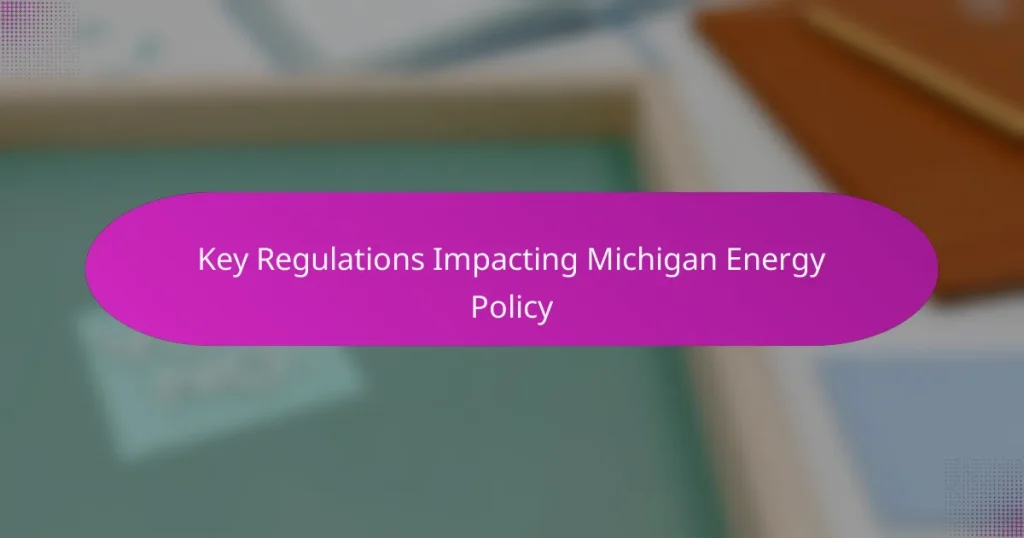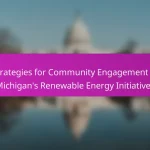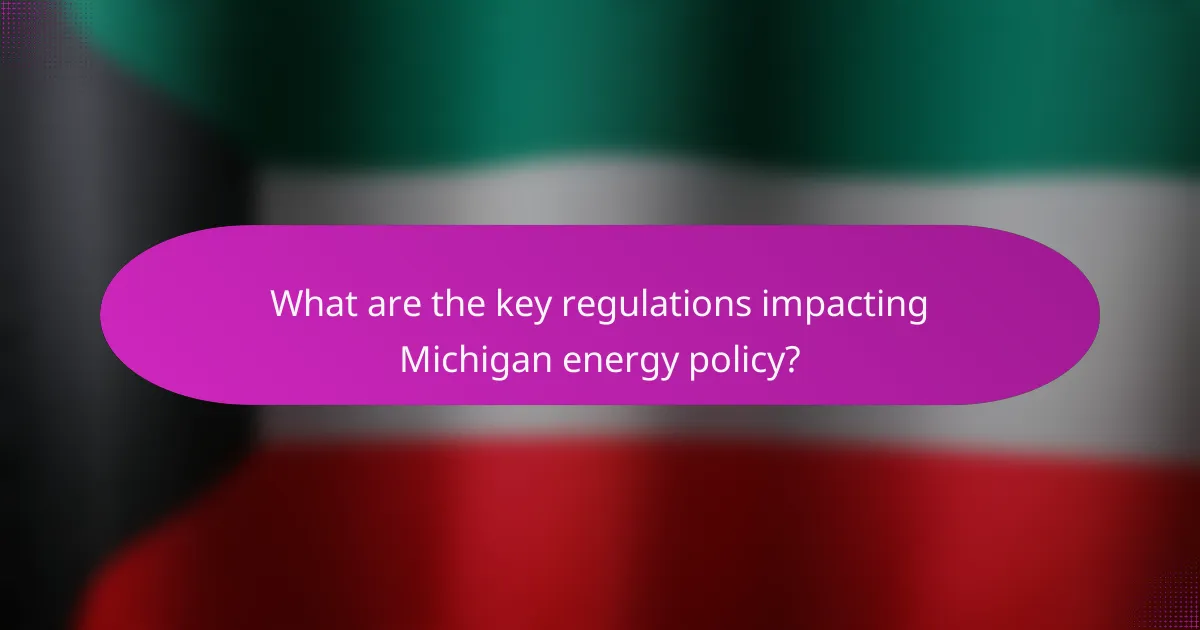
What are the key regulations impacting Michigan energy policy?
The key regulations impacting Michigan energy policy include the Clean and Renewable Energy Standards. These standards mandate that utilities obtain a certain percentage of their energy from renewable sources. The state requires utilities to achieve a renewable energy portfolio standard of 15% by 2021. Additionally, the Michigan Public Service Commission oversees energy regulation and ensures compliance with these standards. The 2008 Energy Optimization Act also mandates energy efficiency programs for utilities. These regulations aim to promote sustainable energy practices and reduce greenhouse gas emissions.
How do these regulations shape the energy landscape in Michigan?
Regulations shape the energy landscape in Michigan by promoting renewable energy sources and energy efficiency. The state’s Renewable Portfolio Standard mandates that utilities obtain 15% of their energy from renewable sources by 2021. This requirement has led to increased investment in wind and solar power. Additionally, energy efficiency programs are encouraged through regulations that aim to reduce overall energy consumption. The Clean and Renewable Energy Act supports these initiatives by providing financial incentives for renewable energy projects. As a result, Michigan’s energy mix is gradually shifting towards cleaner alternatives, reducing reliance on fossil fuels. This transition is crucial for meeting state and federal emissions targets. Overall, these regulations are transforming Michigan’s energy sector into a more sustainable and resilient system.
What are the historical contexts of these regulations?
The historical contexts of these regulations stem from significant energy crises and policy shifts in Michigan. The 1970s oil embargo prompted a reevaluation of energy dependence. In response, Michigan initiated energy conservation measures and renewable energy initiatives. The Public Utility Regulatory Policies Act of 1978 encouraged energy efficiency and alternative energy sources. In the 1990s, deregulation efforts aimed to increase competition in the energy market. The 2008 energy law aimed to promote renewable energy and energy efficiency standards. These historical events shaped the current regulatory framework and energy policy in Michigan.
How have recent developments influenced these regulations?
Recent developments have significantly influenced energy regulations in Michigan. The introduction of new technologies has prompted updates to existing policies. For example, advancements in renewable energy sources have led to increased mandates for clean energy adoption. Legislative changes have also emerged in response to climate change initiatives. The state’s commitment to reducing greenhouse gas emissions has shaped regulatory frameworks. Public input has become more integral in shaping these regulations. Additionally, economic shifts and market dynamics have necessitated adjustments to utility regulations. Overall, these developments have driven a more adaptive regulatory environment in Michigan’s energy policy.
What are the main objectives of Michigan’s energy regulations?
The main objectives of Michigan’s energy regulations are to ensure reliable energy supply, promote renewable energy development, and enhance energy efficiency. These regulations aim to protect consumers while fostering competition among energy providers. They also seek to reduce greenhouse gas emissions and support the state’s transition to a cleaner energy economy. The Michigan Public Service Commission oversees these regulations and implements policies that encourage investment in sustainable energy sources. By 2025, Michigan aims to achieve 15% of its energy from renewable sources, demonstrating a commitment to environmental sustainability.
How do these objectives align with national energy goals?
The objectives align with national energy goals by promoting renewable energy and reducing greenhouse gas emissions. National energy goals emphasize sustainability and energy independence. Michigan’s objectives support these goals through initiatives like increasing renewable energy standards. The state aims for 50% renewable energy by 2030, which mirrors national targets. Furthermore, Michigan’s commitment to energy efficiency complements federal energy policies. This alignment enhances collaboration between state and national efforts. Ultimately, both levels seek to transition to a low-carbon economy.
What role do renewable energy sources play in these objectives?
Renewable energy sources are crucial for achieving Michigan’s energy policy objectives. They contribute to reducing greenhouse gas emissions significantly. In 2020, Michigan aimed for a 28% reduction in emissions by 2025. Renewable energy also enhances energy independence by decreasing reliance on fossil fuels. The state has set a goal of reaching 50% renewable energy by 2030. This transition supports job creation in the renewable sector, with over 100,000 jobs projected by 2025. Additionally, renewable energy sources improve public health by reducing air pollution. These factors collectively align with Michigan’s commitment to sustainable energy practices.
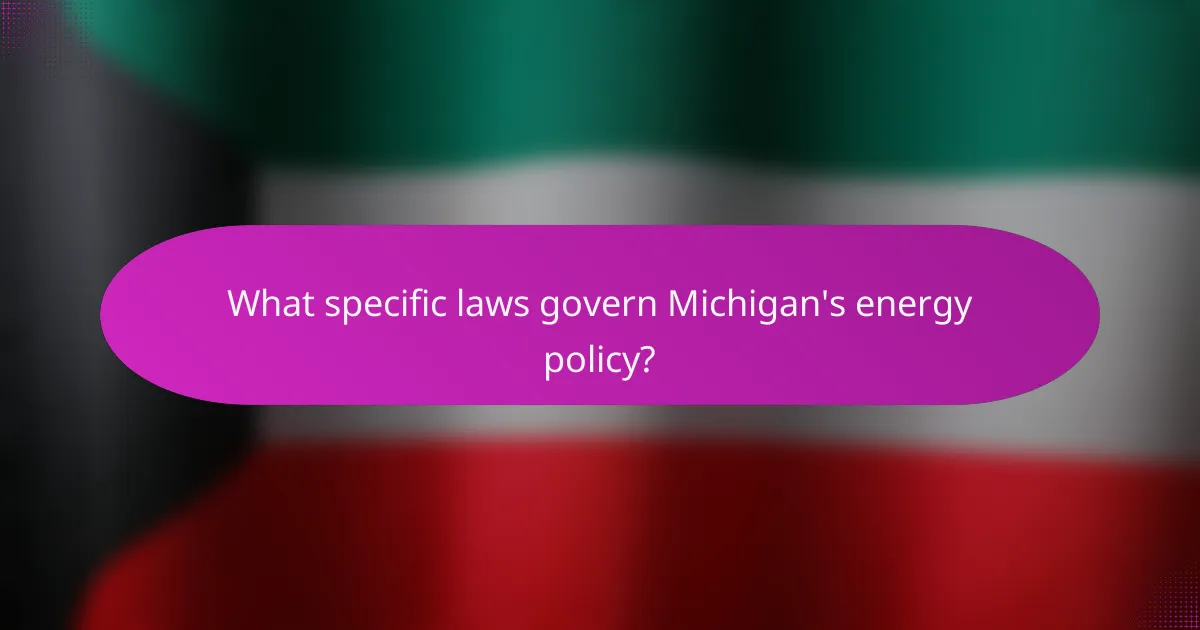
What specific laws govern Michigan’s energy policy?
The specific laws governing Michigan’s energy policy include the Public Act 341 of 2016 and the Public Act 342 of 2016. Public Act 341 establishes the framework for electric utility regulation and energy efficiency programs. Public Act 342 focuses on the resource planning and procurement processes for electric utilities. These laws promote renewable energy standards and energy waste reduction initiatives. They also set requirements for integrated resource planning by utilities. Together, these acts shape Michigan’s approach to energy generation, distribution, and conservation.
What is the significance of the Clean Energy Act in Michigan?
The Clean Energy Act in Michigan is significant because it establishes a framework for increasing renewable energy sources and reducing greenhouse gas emissions. This legislation aims for a 50% reduction in carbon emissions by 2030. It also mandates that 25% of the state’s energy comes from renewable sources by 2025. The Act supports energy efficiency programs to lower overall energy consumption. Furthermore, it encourages investments in clean energy technologies. This initiative aligns Michigan with national trends toward sustainable energy practices. The Clean Energy Act is crucial for fostering economic growth in the renewable sector. It ultimately aims to create a cleaner environment for future generations.
How does the Clean Energy Act promote renewable energy?
The Clean Energy Act promotes renewable energy by establishing mandates for increasing renewable energy generation. It requires utilities to obtain a certain percentage of their energy from renewable sources. This percentage increases over time, encouraging investment in solar, wind, and other renewable technologies. The Act also provides financial incentives for renewable energy projects. These incentives include tax credits and grants for both producers and consumers. Additionally, the Act facilitates the development of renewable energy infrastructure. By streamlining permitting processes, it reduces barriers for new projects. Overall, the Clean Energy Act aims to transition Michigan’s energy portfolio toward sustainable sources.
What are the implications of the Clean Energy Act for consumers?
The Clean Energy Act has significant implications for consumers. It promotes the use of renewable energy sources, which can lead to lower energy costs over time. Consumers may benefit from incentives for energy efficiency upgrades and renewable energy installations. The Act also mandates utilities to increase their renewable energy portfolios, which can enhance energy reliability. Additionally, consumers might experience improved air quality and health benefits due to reduced emissions. The Act aims to create a more sustainable energy market, ultimately benefiting consumers financially and environmentally.
How does the Public Service Commission influence Michigan energy regulations?
The Public Service Commission (PSC) influences Michigan energy regulations through oversight and policy implementation. The PSC regulates utility rates and service quality for electric and gas providers. It ensures compliance with state laws and promotes fair competition in the energy market. The PSC also reviews and approves energy plans submitted by utilities. These plans must align with state energy goals and regulations. Additionally, the PSC conducts public hearings to gather input from stakeholders. This engagement helps shape energy policies that reflect community needs. The PSC’s decisions directly impact the availability and cost of energy in Michigan.
What are the key functions of the Public Service Commission?
The key functions of the Public Service Commission (PSC) include regulating public utilities, ensuring fair rates, and promoting safe and reliable service. The PSC oversees the rates charged by utilities to ensure they are just and reasonable for consumers. It also evaluates and approves utility service quality standards. Additionally, the PSC facilitates the development of energy policies that promote efficiency and renewable energy sources. The commission conducts investigations into utility practices and consumer complaints. Furthermore, it plays a role in the licensing and certification of utility providers. These functions are essential for maintaining a balanced energy market in Michigan.
How does the Commission regulate utility rates and services?
The Commission regulates utility rates and services through a structured process. It evaluates rate requests submitted by utility companies. The Commission conducts hearings to gather evidence and hear public comments. It assesses the utility’s cost of service, ensuring rates are just and reasonable. The Commission also establishes rules for service quality and reliability. It monitors compliance through regular audits and reporting requirements. This process ensures transparency and accountability in utility operations. The regulatory framework aims to protect consumers while ensuring utilities can operate sustainably.
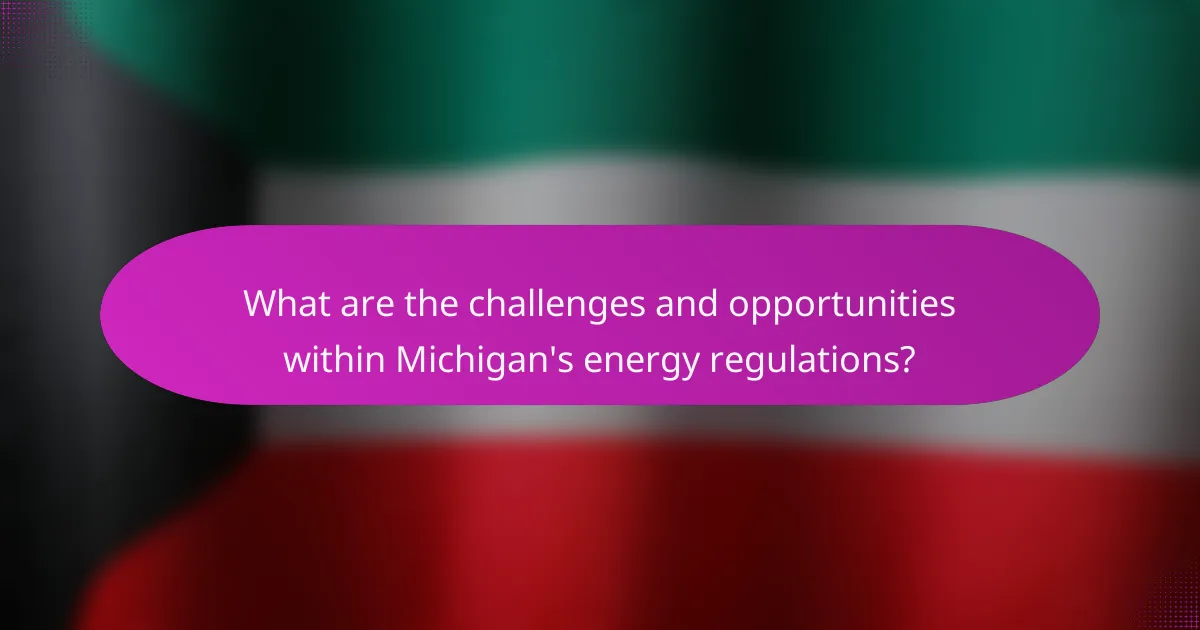
What are the challenges and opportunities within Michigan’s energy regulations?
Michigan’s energy regulations face several challenges and present unique opportunities. A primary challenge is the aging infrastructure, which requires significant investment for upgrades. According to the Michigan Public Service Commission, approximately $10 billion is needed to modernize the grid. Additionally, regulatory complexity can hinder the swift implementation of renewable energy projects.
On the opportunity side, Michigan’s commitment to renewable energy targets can drive innovation. The state aims for 50% renewable energy by 2030, which opens avenues for new technology and job creation. Furthermore, the growing focus on energy efficiency programs presents opportunities for cost savings for consumers and businesses.
The balance between environmental goals and economic impacts remains a key consideration in shaping future regulations. As Michigan navigates these challenges and opportunities, stakeholder engagement will be crucial for effective policy development.
What challenges do stakeholders face in complying with these regulations?
Stakeholders face several challenges in complying with energy regulations in Michigan. These challenges include navigating complex regulatory frameworks. The regulations often involve multiple agencies, leading to confusion. Stakeholders may also struggle with the costs associated with compliance. Financial burdens can arise from necessary upgrades to infrastructure. Additionally, there may be a lack of clarity in regulatory requirements. This ambiguity can result in unintentional non-compliance. Stakeholders often have to invest significant time in understanding the regulations. Limited resources can hinder their ability to meet compliance deadlines. Overall, the combination of complexity, cost, and resource constraints creates significant challenges.
How do economic factors impact regulatory compliance?
Economic factors significantly influence regulatory compliance by affecting the resources available for adherence. When economic conditions are strong, organizations typically have more financial resources to invest in compliance measures. This can include hiring additional staff, implementing new technologies, and training employees on regulatory requirements. Conversely, during economic downturns, companies may cut costs, leading to reduced investment in compliance.
Research shows that businesses facing financial constraints often prioritize immediate operational needs over compliance initiatives. A study by the Harvard Business Review found that companies under financial stress are more likely to experience compliance failures. Additionally, economic factors can drive changes in regulatory frameworks. For instance, economic growth may prompt governments to impose stricter regulations to ensure sustainable practices.
In summary, economic factors directly impact the capacity of organizations to comply with regulations, influencing both their ability to allocate resources and the regulatory landscape itself.
What are the environmental considerations in these regulations?
Environmental considerations in these regulations focus on reducing emissions and promoting sustainability. These regulations aim to protect air and water quality. They also encourage the use of renewable energy sources. For instance, regulations may mandate a certain percentage of energy to come from wind or solar. Additionally, there are requirements for energy efficiency in buildings. These measures help minimize the carbon footprint. Compliance with these regulations supports Michigan’s goals for a cleaner environment. Overall, these considerations align with broader climate change initiatives.
What opportunities exist for innovation in Michigan’s energy sector?
Michigan’s energy sector has several opportunities for innovation. The state aims to increase the use of renewable energy sources. Michigan’s Renewable Portfolio Standard mandates that 15% of energy must come from renewables by 2021. This creates a demand for solar and wind technologies. Additionally, advancements in energy storage solutions can enhance grid reliability. The state’s commitment to reducing carbon emissions encourages electric vehicle infrastructure development. Furthermore, public-private partnerships can foster research in energy efficiency. The Michigan Energy Innovation Business Council supports startups in clean energy technologies. These factors collectively drive innovation in Michigan’s energy landscape.
How can emerging technologies enhance compliance with energy regulations?
Emerging technologies can enhance compliance with energy regulations by automating monitoring and reporting processes. Smart meters and IoT devices provide real-time data on energy consumption. This data helps organizations to quickly identify inefficiencies and non-compliance issues. Advanced analytics can predict potential regulatory breaches before they occur. Blockchain technology can ensure transparent and tamper-proof records of energy transactions. These technologies facilitate easier audits and compliance checks. According to a report by the International Energy Agency, digital technologies can reduce compliance costs by up to 30%. Enhanced data accuracy leads to better decision-making and regulatory adherence.
What best practices can stakeholders adopt to navigate Michigan energy regulations effectively?
Stakeholders can adopt several best practices to navigate Michigan energy regulations effectively. First, they should stay informed about current regulations and legislative changes. Regularly reviewing updates from the Michigan Public Service Commission (MPSC) is essential. Second, engaging in public comment periods allows stakeholders to voice their opinions on proposed regulations. This participation can influence policy decisions. Third, building relationships with regulatory agencies can facilitate better communication. Networking with MPSC officials can provide insights into regulatory processes. Fourth, collaborating with industry associations can amplify stakeholders’ voices. These organizations often have resources and expertise to navigate complex regulations. Lastly, investing in compliance training helps stakeholders understand their obligations. This proactive approach reduces the risk of non-compliance. These practices collectively enhance stakeholders’ ability to operate effectively within Michigan’s regulatory landscape.
The main entity of this article is Michigan energy policy, specifically focusing on the key regulations that shape it. The article examines significant regulations such as the Clean and Renewable Energy Standards, the Energy Optimization Act, and the Clean Energy Act, detailing their roles in promoting renewable energy, energy efficiency, and compliance oversight by the Michigan Public Service Commission. It further explores the historical context, recent developments, and objectives of these regulations, as well as the challenges and opportunities they present for stakeholders. Additionally, the article highlights the implications of these regulations for consumers and the environment, emphasizing the importance of innovation and best practices in navigating Michigan’s energy landscape.
